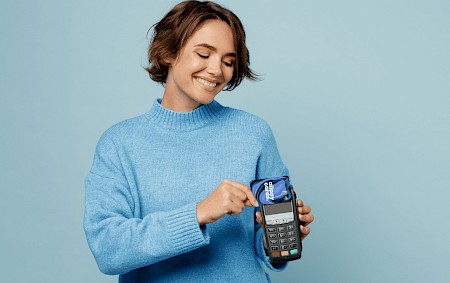Get the latest updates
Follow @allpay_cards on XChelsi Jones, Account Management Assistant at allpay Cards, shares her thoughts on the evolving world of payments. Chelsi talks about how the payment world has moved on from cash to digital payments, contactless cards, wearables and biometrics.
Convenience has been the main driver in the evolution of payment technology over the years. When it comes to purchasing everyday items, we prefer the quick and easy method of contactless or paying via smartphones as opposed to using traditional notes or coins. The current trend of mobile payments points towards the next evolutionary step as being a cashless future with all payments being via digital, voice or via mobile devices.
However, this theory of a cashless future has yet to develop as even with the current mobile payment options available, penetration has been relatively low in order to be solely relied upon to lead to the abolishment of all cards, coins and notes.
There are a number of reasons for this, for example some shops are yet to be able to process Apple or Samsung Pay and other mobile payment apps, with smaller businesses struggling to keep up with evolving and more expensive modern technology.
Furthermore, by relying on mobile payments completely, there is no fall back option in the event your phone ends up broken or out of juice. If a shop is having issues processing card payments, you are still able to use your nearest ATM and withdraw cash to make your purchase. Whilst some banks offer a way of retrieving cash from ATMs via your mobile app this is yet to be scaled across multiple providers and therefore provides an issue for the mass market.
Contactless payments have grown rapidly over the past few years with contactless transactions in the UK rising by 166% in 2016 while bringing the percentage of overall transactions up by 111%. In 2017 contactless transactions rose by 157% despite the number of overall transactions only rising by 47%. This implies that we are becoming more comfortable with contactless technology and therefore is a dominant method of payment today.
One downfall of contactless payments would be the increased risk of fraud compared to chip and pin payments. Although there are cases of this happening, they are extremely rare. In the UK for instance, where contactless payments make up more than a third of overall card transactions, contactless cards and devices accounted for just over 1 percent of card fraud in 2016 — up from 0.5 percent the previous year, according to Financial Fraud Action UK.
Contactless is not only an easy method of payment but is also extremely convenient, saving people time. The time taken to perform two contactless transactions instead of cash can save you on average 30 seconds per day, 3.5 minutes per week and 15 minutes per month. There are also improvements in reducing queuing times, for example if everyone in a 10-person queue used a contactless payment method, the 1st person in line will save 15 seconds and the 10th will end up saving 2.5 minutes. In 2018, 10.1 billion contactless transactions are expected to be made which will end up saving Brits 19.6 million hours compared to chip and pin and 42.1 million hours compared to cash.
Adam Herson, business development director at Barclays Mobile Payments, said:
“Contactless payments are now part of everyday life for millions of Britons. As a result, increasingly over the past year we have seen a dramatic interest in a new generation of payment systems – chips that can be seamlessly incorporated into items of clothing, watches or jewellery. I would expect to see this area grow exponentially over the next 12 months.”
A good example of contactless being incorporated into everyday objects would be Kerv. Kerv is the world’s first Mastercard® contactless payment ring; it’s the first of its kind and the beginning of the next-generation wearable payment devices where there is a great deal of technology innovation, more of which will be discussed next week folks!






